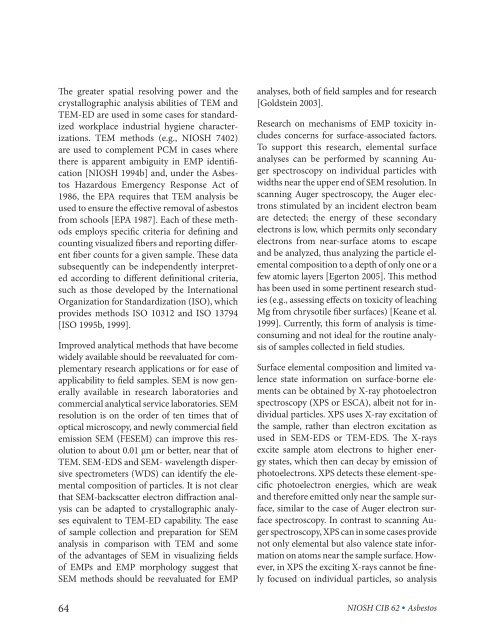Asbestos Fibers and Other Elongate Mineral Particles: State of the ...
Asbestos Fibers and Other Elongate Mineral Particles: State of the ...
Asbestos Fibers and Other Elongate Mineral Particles: State of the ...
- No tags were found...
Create successful ePaper yourself
Turn your PDF publications into a flip-book with our unique Google optimized e-Paper software.
The greater spatial resolving power <strong>and</strong> <strong>the</strong><br />
crystallographic analysis abilities <strong>of</strong> TEM <strong>and</strong><br />
TEM-ED are used in some cases for st<strong>and</strong>ardized<br />
workplace industrial hygiene characterizations.<br />
TEM methods (e.g., NIOSH 7402)<br />
are used to complement PCM in cases where<br />
<strong>the</strong>re is apparent ambiguity in EMP identification<br />
[NIOSH 1994b] <strong>and</strong>, under <strong>the</strong> <strong>Asbestos</strong><br />
Hazardous Emergency Response Act <strong>of</strong><br />
1986, <strong>the</strong> EPA requires that TEM analysis be<br />
used to ensure <strong>the</strong> effective removal <strong>of</strong> asbestos<br />
from schools [EPA 1987]. Each <strong>of</strong> <strong>the</strong>se methods<br />
employs specific criteria for defining <strong>and</strong><br />
counting visualized fibers <strong>and</strong> reporting different<br />
fiber counts for a given sample. These data<br />
subsequently can be independently interpreted<br />
according to different definitional criteria,<br />
such as those developed by <strong>the</strong> International<br />
Organization for St<strong>and</strong>ardization (ISO), which<br />
provides methods ISO 10312 <strong>and</strong> ISO 13794<br />
[ISO 1995b, 1999].<br />
Improved analytical methods that have become<br />
widely available should be reevaluated for complementary<br />
research applications or for ease <strong>of</strong><br />
applicability to field samples. SEM is now generally<br />
available in research laboratories <strong>and</strong><br />
commercial analytical service laboratories. SEM<br />
resolution is on <strong>the</strong> order <strong>of</strong> ten times that <strong>of</strong><br />
optical microscopy, <strong>and</strong> newly commercial field<br />
emission SEM (FESEM) can improve this resolution<br />
to about 0.01 µm or better, near that <strong>of</strong><br />
TEM. SEM-EDS <strong>and</strong> SEM- wavelength dispersive<br />
spectrometers (WDS) can identify <strong>the</strong> elemental<br />
composition <strong>of</strong> particles. It is not clear<br />
that SEM- backscatter electron diffraction analysis<br />
can be adapted to crystallographic analyses<br />
equivalent to TEM-ED capability. The ease<br />
<strong>of</strong> sample collection <strong>and</strong> preparation for SEM<br />
analysis in comparison with TEM <strong>and</strong> some<br />
<strong>of</strong> <strong>the</strong> advantages <strong>of</strong> SEM in visualizing fields<br />
<strong>of</strong> EMPs <strong>and</strong> EMP morphology suggest that<br />
SEM methods should be reevaluated for EMP<br />
64<br />
analyses, both <strong>of</strong> field samples <strong>and</strong> for research<br />
[Goldstein 2003].<br />
Research on mechanisms <strong>of</strong> EMP toxicity includes<br />
concerns for surface-associated factors.<br />
To support this research, elemental surface<br />
analyses can be performed by scanning Auger<br />
spectroscopy on individual particles with<br />
widths near <strong>the</strong> upper end <strong>of</strong> SEM resolution. In<br />
scanning Auger spectroscopy, <strong>the</strong> Auger electrons<br />
stimulated by an incident electron beam<br />
are detected; <strong>the</strong> energy <strong>of</strong> <strong>the</strong>se secondary<br />
electrons is low, which permits only secondary<br />
electrons from near-surface atoms to escape<br />
<strong>and</strong> be analyzed, thus analyzing <strong>the</strong> particle elemental<br />
composition to a depth <strong>of</strong> only one or a<br />
few atomic layers [Egerton 2005]. This method<br />
has been used in some pertinent research studies<br />
(e.g., assessing effects on toxicity <strong>of</strong> leaching<br />
Mg from chrysotile fiber surfaces) [Keane et al.<br />
1999]. Currently, this form <strong>of</strong> analysis is timeconsuming<br />
<strong>and</strong> not ideal for <strong>the</strong> routine analysis<br />
<strong>of</strong> samples collected in field studies.<br />
Surface elemental composition <strong>and</strong> limited valence<br />
state information on surface-borne elements<br />
can be obtained by X-ray photoelectron<br />
spectroscopy (XPS or ESCA), albeit not for individual<br />
particles. XPS uses X-ray excitation <strong>of</strong><br />
<strong>the</strong> sample, ra<strong>the</strong>r than electron excitation as<br />
used in SEM-EDS or TEM-EDS. The X-rays<br />
excite sample atom electrons to higher energy<br />
states, which <strong>the</strong>n can decay by emission <strong>of</strong><br />
photoelectrons. XPS detects <strong>the</strong>se element-specific<br />
photoelectron energies, which are weak<br />
<strong>and</strong> <strong>the</strong>refore emitted only near <strong>the</strong> sample surface,<br />
similar to <strong>the</strong> case <strong>of</strong> Auger electron surface<br />
spectroscopy. In contrast to scanning Auger<br />
spectroscopy, XPS can in some cases provide<br />
not only elemental but also valence state information<br />
on atoms near <strong>the</strong> sample surface. However,<br />
in XPS <strong>the</strong> exciting X-rays cannot be finely<br />
focused on individual particles, so analysis<br />
NIOSH CIB 62 • <strong>Asbestos</strong>

















